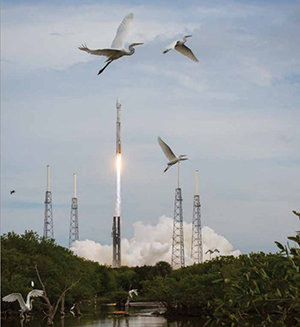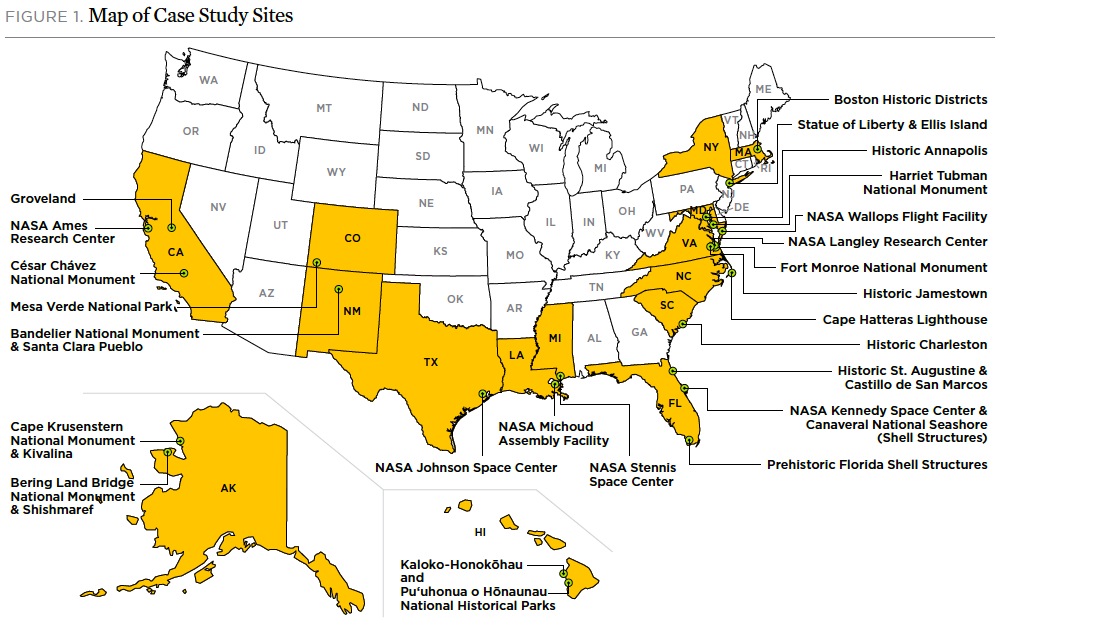UNION OF CONCERNED SCIENTISTS
National Landmarks at Risk
How Rising Seas, Floods, and Wildfires Are Threatening the United States’ Most Cherished Historic Sites
Introduction
 Many of the United States’ iconic landmarks and
Many of the United States’ iconic landmarks and
heritage sites are at risk as never before. Sea level
rise, coastal erosion, increased flooding, heavy rains,
and more frequent large wildfires are damaging
archaeological resources, historic buildings, and
cultural landscapes across the nation.
From sea to rising sea, a remarkable number of the places where American history was made are already under threat. The geographic and cultural quilt that tells the American story is fraying at the edges—and even beginning to be pulled apart—by the impacts of climate change.
This report is not a comprehensive analysis of climate change threats to all of the United States’ historic places, monuments and memorials, but rather a selection of case studies that vividly illustrate an urgent problem. These examples represent just a few of the many that could have been included, but the places they examine symbolize many of the rich and diverse elements of the American experience. The stories were chosen because the science behind the risks they face is robust, and because together they shine a spotlight on the different kinds of climate impacts already affecting the United States’ cultural heritage.
The Range and Scale of Impacts Are Alarming
The range and scale of impacts are alarming. Coastal erosion in Alaska is washing away irreplaceable archaeological sites that chronicle some of the earliest people in the Americas, and also threatening the existence of native villages whose hunter-gatherer traditions originated thousands of years ago. Waves from rising seas batter the walls of ancient Hawaiian sacred sites and jeopardize future operations at Kennedy Space Center, where Apollo and many other pioneering missions were launched. Elsewhere along the Atlantic coast, historic districts, including those of Boston and Annapolis, are experiencing more frequent and severe coastal flooding and storm surges. Meanwhile, worsening wildfires are affecting nineteenth-century California Gold Rush towns and ancient pueblos in New Mexico and Colorado.
The landmarks discussed in this report include historic Jamestown, the U.S. Naval Academy, and Castillo de San Marcos. Ellis Island, where millions of Americans’ ancestors entered the country for the first time, was closed to visitors for more than a year after Hurricane Sandy. Affected places include some of the oldest, as well as some of the most recently designated. Consider, for instance, that two of the nation’s newest national monuments—sites commemorating Harriett Tubman in Maryland and Fort Monroe in Virginia—already face an imminent threat from sea level rise.
All of the case studies in this report draw on observations of impacts that are either consistent with, or attributable to, human-induced climate change based on multiple lines of scientific evidence. Some of the sites face the risk of severe damage or even eventual loss. Other case studies describe sites which are just now seeing the first signs of damage, or are experiencing disruptions to access and services that are likely to become worse, more frequent, or both. All provide a wake-up call: as the impacts of climate change continue, we must make hard choices now and take urgent steps to protect these sites and reduce the risks.
Download full version (PDF): Our National Landmarks at Risk
About the Union of Concerned Scientists
www.ucsusa.org
“The Union of Concerned Scientists is the leading science-based nonprofit working for a healthy environment and a safer world. UCS combines independent scientific research and citizen action to develop innovative, practical solutions and to secure responsible changes in government policy, corporate practices, and consumer choices.”
Tags: National Landmarks, Sea Level Rise, SLR, Union of Concerned Scientists







 RSS Feed
RSS Feed